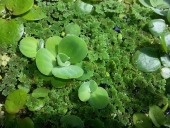




John Natoli wrote:I'd echo William's concern about the ducks eating all the vegetation. I have three very young ducks and they gobble up duckweed faster than I can get it in the pond which has about a 1000 sq ft surface. Looking forward to seeing your calculations on that as they may help me out!

Mike Jay wrote:
As for the walls, have you seen the wofati construction method? Logs and boards form the walls with bracing to keep them from tipping in. They have plastic on the earthen side to keep them from rotting as quickly. The pond would have to not touch the logs so a small walkway around the perimeter of the pond could ensure separation.

Mike Jay wrote:The concept I'm thinking for "geothermal" would be to dig the equivalent of a hand dug well about 8' deep. Or however deep you can safely and easily do. Or do several. Then support the sides with stone work, block or a piece of road culvert. The top of the well or culvert would be at the bottom of your pond depth so the pond is sitting on top and connected to the water in the deep well.
In my greenhouse design I planned on R20 for the first 4 feet underground. By doing that, the ensuing heat loss was indeed negligible.

William Bronson wrote:John,if the fish have free access to the plants and the ducks free access to the fish and the plants,you might find yourself without either fish or plants.
On the other hand, allowing ducks access to a pond without filters or water changes of some sort is probably asking for trouble.
You could segregate the plants with floating cages , but im not sure what would allow ducks and fish to coexist in a pond at this scale.
Floating your structure on the pond might be cheaper and easier than building a steel span.

Mike Jay wrote:What temperature do the water plants need in order to proliferate at the needed rate?
Will you insulate the part of the E, W and North walls that are within 4' of the surface of the surrounding soil? I can understand the concept of not insulating the bottom of the pond so that it harnesses the semi-deep earth temps. Just don't forget that any soil near the surface and touching your greenhouse will be frozen in the winter and will suck the heat out.
One idea that comes to mind is that you could dig the pond extra deep in a couple spots to tie into warmer/deeper temperatures. Steep pond sides are a challenge but I'm imagining a 2-4' diameter pipe or culvert standing on end. It would hold back the dirt and the water inside it could "mine" heat from below. I'm not sure if the convection of that heat would be sufficient to actually help heat the building...

Mark Tudor wrote:Would the indoor pond be fully lined with insulation underneath to thermally separate it from the earth underneath? I'm wondering that as Tilapia require rather warm water to be productive and survive, relative to catfish. Depending how deep the pond is, the earth underneath will be a heat sink and draw heat from the water, possibly making it too cold for the tropical fish (depending on location).
You might find some other species which are more tolerant of varied conditions similar to catfish, or if the pond is deep enough a colder variety may work better.
